Bluefin Tuna
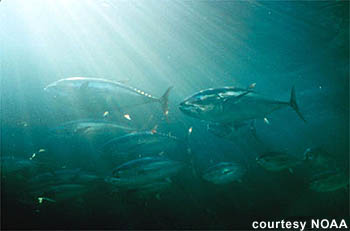
Thunnus thynnus
These torpedo-shaped fish are the largest of the tunas, growing to an average of 78 inches long, but recorded at 180 inches and over 1,500 pounds. They are strong and fast swimmers with black-edged yellow finlets running back from curved dorsal and anal fins to a crescent caudal (tail) fin. They are metallic dark blue above, fading to a silver white below, with faint bars and spots on their sides. Very popular as a food fish, both recreational and commercial fisheries have helped to exploit the populations to the point of concern.
Order – Perciformes
Family – Scombridae
Genus – Thunnus
Species – thynnus
Common Names
English language common names include bluefin tuna, Atlantic bluefin tuna, blue fin tuna, bluefin tunny, blue-fin tunny, northern bluefin tuna, and squid hound. European language names include aleta azul (Spanish), atun (Spanish), an tuinnín (Irish), atún aleta azul (Spanish), auhopu (Tahitian), blåfinnet tunfisk (Danish), blouvin-tuna (Afrikaans), cá chan (Mandarin Chinese), kuromaguro (Japanese), makrellstørje (Norwegian), musciame de tonno (Italian), obyknovennyi tunets (Russian), albacora, alvacor, atuarro, atum, atum-azul, mochama, rabil, rabilha, rabilo, thon rouge, thon rouge de l’Atlantique, atún aleta azul, atún rojo del Atlántico (Portuguese), roter thun (German), sjorje (Norwegian), thon rouge (French), thone (French), thunfisch (German), thunfisk (Norwegian), tonijn (Dutch), tonnikala (Finnish), tonno (Italian), tonyina (Catalan), tun (Danish), and tunfisk (Danish). Other language common names include blouvin-tuna (Afrikaans), toun ahmar, tunna (Arabic), thu (Chinese), tunna kehula (Hebrew), kuromagura (Japanese), zoludoj tunets (Russian), auhopu (Tahitian), and orkinos (Turkish).
Importance to Humans
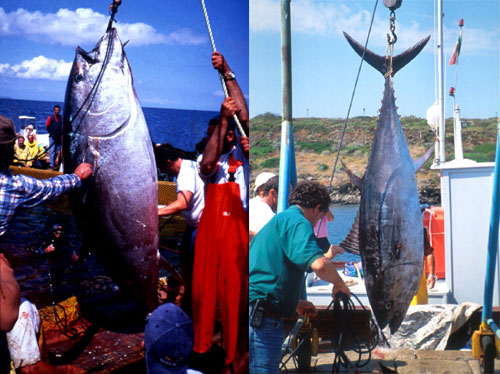
These torpedo-shaped fish are the largest of the tunas, growing to an average of 78 inches long, but recorded at 180 inches and over 1,500 pounds. They are strong and fast swimmers with black-edged yellow finlets running back from curved dorsal and anal fins to a crescent caudal (tail) fin. They are metallic dark blue above, fading to a silver white below, with faint bars and spots on their sides. Very popular as a food fish, both recreational and commercial fisheries have helped to exploit the populations to the point of concern.
The bluefin is highly valued as a food fish around the world. It is sold fresh or frozen. Quality fish are especially favored in Japan, where they can fetch a high price in the raw seafood market. A single fish can sell for $45,000 USD.
The bluefin tuna is also a popular game fish, especially in the USA, where it is caught by hook and line. In some areas, it is reported that bluefin do not readily take bait. Instead, they will bite only when in mixed schools including albacore or yellowfin. Scientists speculate that the intense feeding activity of these other species may stimulate a feeding response in bluefin tuna.
Conservation

The popularity of this tuna in commercial markets has led to severe exploitation in several areas, most notably in the North Atlantic Ocean. Because bluefin migrate long distances, and because much of the fishery occurs in international waters, international cooperation is necessary in management decisions. The International Commission for the Conservation of Atlantic Tunas was created in 1966 to specifically address the conservation issues facing the bluefin and other highly migratory species. (link to ICCAT) Over twenty nations are now active in this organization, including the US, Canada, Japan, Spain, and France. ICCAT attempts to organize and coordinate international research, and proposes management regulations. Major issues facing the commission are reasonable definitions of management units and development of reliable abundance estimates.
> Check the status of the bluefin tuna at the IUCN website.
The IUCN is a global union of states, governmental agencies, and non-governmental organizations in a partnership that assesses the conservation status of species.
Geographical Distribution

The bluefin tuna is distributed throughout the Atlantic and Pacific Oceans in subtropical and temperate waters. In the western Atlantic Ocean, it is found from Labrador, Canada, to northern Brazil, including the Gulf of Mexico. In the eastern Atlantic Ocean, it is found from Norway to the Canary Islands. In the western Pacific Ocean, it is distributed from Japan to the Philippines. In the eastern Pacific Ocean, it is distributed from the southern coast of Alaska, USA to Baja California, Mexico.
Habitat
This tuna is epipelagic and oceanic, coming near shore seasonally. It can tolerate a considerable range of temperatures and has been observed both above and below the thermocline, down to depths of greater than 3000 feet (914.4 m).
Bluefin tuna exhibit strong schooling behavior while they are young. While schooling is believed to be sight oriented, schools have been observed at night. Therefore, other senses (particularly the lateral line) appear to be involved in this behavior. Schools of bluefin seasonally migrate northward during the summer months along the coast of Japan and and the Pacific coast of North America. Tagged adult fish have made trans-Pacific migrations: some eastward, and some westward. Other tagging studies have shown that a bluefin can cross the Atlantic in less than 60 days. They can swim at speeds up to 45 mph (72.5 kph).
Biology
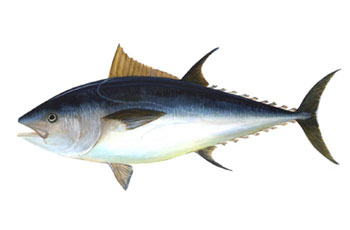
Distinctive Features
The bluefin tuna is one of the largest of the tunas. The body is deepest near the insertion of the pelvic fins, and tapers significantly to the caudal peduncle. Compared to other tunas, the head is long and somewhat pointed, and the eye is small. Two dorsal fins are present, with a small space separating them. The second dorsal fin is taller than the first, and is followed by 7 to 10 finlets. The anal fin begins well behind the insertion of the second dorsal fin. The pectoral fins are short compared to other members of the genus Thunnus, although the relative length changes with age. The pectoral fins never reach as far back as the space between the dorsal fins. Three keels are present on the caudal peduncle.
Coloration
The body is a metallic deep blue above and the lower sides and belly are silvery white. In fresh specimens, alternating colorless lines and rows of dots can be seen along the lower sides. The first dorsal fin is yellow or blue, the second is red or brown. The anal fin and finlets are yellow, edged with black. The central caudal keel is black.
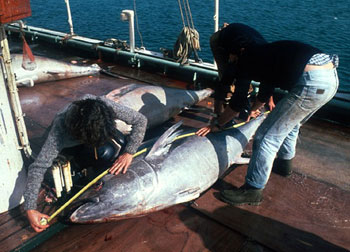
Size, Age, and Growth
The maximum length reported is 180 inches (458.0 cm) total length and the maximum weight reported is 1,506 lbs. (684 kg). Bluefin commonly attain a size of 78 inches (200 cm). The International Game Fish Association (IGFA) all-tackle record is 1496 lb. (679 kg). This tuna has a life span of approximately 15 years.
Food Habits
Bluefin exhibit different feeding strategies, dependent upon their targeted prey. A quick, energetic pursuit is used in obtaining smaller schooling fishes, particularly anchovies, while “modified filter feeding” is used to catch small, slow moving organisms. Bluefin feeding near shore have been recorded to eat starfish, kelp, and smaller shallow water fishes. Bluefin are less likely to feed during the spawning season, when the majority of their activity must be dedicated to spawning activities. Their major competitors for food are marine mammals and other large fish, notably other scombrids and billfishes.
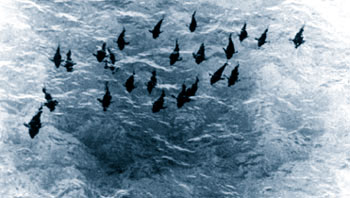
Reproduction
Bluefin tuna are oviparous. In the Atlantic, spawning has been detected in only two areas: the Mediterranean and Gulf of Mexico. In the Pacific, spawning occurs off the Philippines. This is a limited spawning area compared to other tropical tunas. Little is known about the spawning of bluefin, as it has not been observed. Spawning in the Gulf of Mexico occurs from April to June and Mediterranean spawning occurs from June to August. Differences in timing could be due to any of a number of factors, such as differing environmental cues or genetic variation. In the Gulf of Mexico, spawning occurs at temperatures of 76.8 to 85.1 °F(24.9 to 29.5 °C) while in the Mediterranean it occurs at 66 to 70 °F (19-21 °C).
In captivity, bluefin tuna have reached sexual maturity at 3 years, however others have suggested that bluefin become sexually mature at an age 4 to 5 years. Average females produce up to 10 million eggs per year. Their eggs are buoyant, and are distributed a considerable distance by the surface currents. The larvae hatch at a size of 3.0mm. They have large heads and large jaws, and lack body pigmentation. Larvae of Thunnus species are very difficult to distinguish from one another, however bluefin are the only Thunnus species to have dorsal tail pigment. (image from NMFS-SEFC-240) The larvae grow at 1 mm per day. In spawning areas, larval abundance ranges from 0.1 to 1.0 per square yard. The young, up to a size of 90 to 130 lbs. (40 to 80 kg), will separate into schools based upon size. These schools often consist of multiple species, possibly containing albacore, yellowfin, bigeye, skipjack, frigate tuna, bonito, and yellowtail.
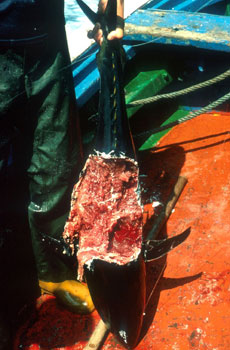
Predators
Marine mammals, including killer whales and pilot whales, feed on the bluefin tuna. Other predators include sharks, other large predatory fishes, and seabirds.Parasites
The bluefin tuna is a host to 72 known parasites out of which 9 are host-specific. Copepods are among the parasites of this tuna including Caligus bonito and C. productus are found on the surface of the body and the wall of the branchial cavities. Euryphorus brachypterus is found on the wall of the branchial cavities and Brachiella thynniis parasitic on the fins. Other parasitic copepods include Pennella filosa which inserts itself into the flesh of the fish and Pseudocycnus appendiculatus found on the gill filaments.
Other parasites associated with this tuna include protozoans, digenea (flukes), didymozoidea (tissue flukes), monogenean (gillworms), cestoda (tapeworms), nematoda (roundworms), acanthocephala (spiny-headed worms), and copepods. The cookiecutter shark (Isistius brasiliensis), largetooth cookiecutter shark (Isistius plutodus), and pilotfish (Naucrates ductor) are fish considered to be parasites of the bluefin tuna.
Taxonomy
The bluefin tuna was first described by Linnaeus in 1758 as Scomber thynnus. A variety of names followed, includingThynnus thynnus, Thunnus vulgaris, and Albacora thynnus. In 1896, Jordan and Evermann first allocated the tuna into the genus Thunnus, now the accepted name. While scientists have debated whether the species actually represents multiple species or subspecies, evidence now suggests that Thunnus thynnus is a single species. The genus name Thunnus is derived from the Greek “thynnos” meaning tunna while the species name thynnus is translated as tunny.
Prepared by: Susie Gardieff